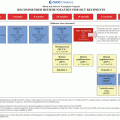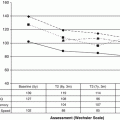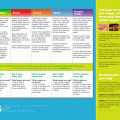DSM-5 major depressive disorder symptoms
• Depressed (or irritable) mood most of the day, nearly every day as indicated by either subjective report (e.g. feels sad or empty) or observation by others (e.g. appears tearful)
NOTE: In children, can be irritable mood
• Markedly diminished pleasure in all, or almost all, activities most of the day, nearly every day
• Significant weight loss when not dieting (e.g. change of >5 % of body weight in a month) or weight gain or decrease or increase in appetite nearly every day
NOTE: In children, consider failure to make expected weight gains
• Insomnia or hypersomnia nearly every day
• Psychomotor agitation or retardation nearly every day (observable by others, not merely subjective feelings of restlessness or being slowed-down)
• Fatigue or loss of energy nearly every day
• Feelings of worthlessness or excessive or inappropriate guilt (which may be delusional) nearly every day (not merely self-reproach or guilt about being sick)
• Diminished ability to think or concentrate, or indecisiveness (either by subjective account or as observed by others)
• Recurrent thoughts of death (not just fear of dying), recurrent suicidal ideation without specific plan, or a suicide attempt or a specific plan for committing suicide
Notably, the DSM-5 criteria specifically instruct clinicians not to include “symptoms that are clearly due to a general medical condition.” Fatigue, pain, endocrine dysfunction, metabolic issues and obesity or obstructive sleep apnea may affect survivors and complicate the differential diagnosis of depression [8, 9, 10]. Neurovegetative symptoms (e.g., sleeplessness, anorexia, fatigue, and psychomotor slowing) may reflect medical conditions rather than depressive symptoms. Brain tumor survivors may also have primary neurologic conditions that affect mood, affect and expression of emotion [7]. When there is a medical cause for these symptoms, the medical condition should be addressed first, with subsequent reevaluation for depression. In patients with significant medical issues where the cause of neurovegetative symptoms may be difficult to discern, persistent subjective depressed mood, anhedonia, defined as a loss of pleasure in activities, and hopelessness may be the most sensitive clinical indicators of depression warranting specific treatment.
27.4.2 Treatment
Antidepressant medications include: Serotonin-specific reuptake inhibitors (SSRI’s) fluoxetine, sertraline, citalopram, escitalopram, paroxetine, fluvoxamine; Serotonin-norepinephrine reuptake inhibitors (SNRI’s) venlafaxine, duloxetine, and desvenlafaxine; and atypical agents, bupropion, nefazodone, mirtazapine, and trazodone. Older agents such as Tricyclic antidepressants (TCA’s) and Monoamine Oxidase inhibitors (MAO’s) have more significant side effects and drug interactions and are now used infrequently, but may have utility in the treatment of more severe or refractory mood disorders. Choice of anti-depressant therapy should consider efficacy and tolerability, co-morbid medical conditions, and potential drug-drug interactions. The relatively low side effect burden of SSRI’s makes then first line treatment for most patients. However, depressed patients with co-morbid physical symptoms such as headache, pain and fatigue may respond less well to SSRI’s than those without such symptoms [35], raising concerns that childhood cancer survivors with physical late effects may be at risk for more refractory symptoms of depression.
It is important to note that the onset of effect for SSRI’s is usually 2–3 weeks, and it may take 4–6 weeks for full effect. The most common adverse effects of SSRI’s include nausea, tremor, headache, excessive sweating, activation or sedation, insomnia, dizziness, rash and dry mouth [36]. Many of these side effects are dose-dependent, and generally subside with time. There is also a rare side effect of toxicity and serotonin syndrome, especially when there are multiple serotonergic agents being taken. Emergence of sexual dysfunction including decreased libido, erectile dysfunction, delayed ejaculation and anorgasmia may occur, and can be a source of non-adherence to treatment [37]. Among the SSRI’s, Citalopram is noted to have the fewest inhibitory effects on cyp450 isoenzymes [38], making it potentially useful when these interactions are of concern to prescribers. Recent US Food and Drug Administration (FDA) warnings about increased risk of prolonged QTc at doses above 40 mg may limit use of Citalopram in higher doses among patients with existing cardiac risk factors [39]
In 2003, the FDA in the United States received unpublished data from placebo-controlled trials which suggested that paroxetine taken by pediatric patients with major depressive disorder might be associated with an elevated risk of “suicide attempts” and “possibly suicide-related” events. In 2007, the FDA made revisions to labeling for SSRI’s and extended caution to young adults, stating that when compared to placebo, antidepressants increased the risk of suicidal thinking and behavior in children, adolescents, and young adults with major depressive disorder and other psychiatric disorders.
Data from large epidemiological studies examining rates of suicidal behavior have found no statistically significant effect of antidepressants on the likelihood of actual suicide attempt [40]. A study of four older antidepressant medications (fluoxetine, paroxetine, amitriptyline, and dothiepin) also concluded there were no significant associations between the use of a particular study antidepressant and the risk of suicide, although the risk of suicidal behavior was observed to be increased in the first month after starting antidepressants [41].
27.4.3 Summary
Survivors who present with symptoms of depression require a careful history, consideration of non-pharamacologic approaches and potential medical causes, and close follow-up. General medical clinicians who use pharmacotherapy should prescribe recommended dosing for antidepressants, with specific caution and dose adjustments in patients with hepatic or renal insufficiency, or cardiac risk factors. Patients should be monitored regularly for treatment efficacy, side effects, and suicidal ideation, especially during initial dose titration. Patients with refractory symptoms need re-assessment and likely referral to specialized mental health clinicians.
27.5 Anxiety
27.5.1 Background
Anxiety may present as a transient state of fear that is triggered by a situation, or may be a more pervasive and intense internal experience that is less influenced by the environment. The common experience of worry that most people experience is distinguished from an anxiety disorder that may warrant medication intervention by the intensity and duration of symptoms, and their independence from or disproportionate reaction to external factors. Anxiety disorders are characterized by fears that take on “a life of their own,” are not eased by changing situations or reassurance, and significantly interfere with function. Anxiety is associated with cognitive, physiologic and behavioral components. Table 27.2 describes common anxiety disorders that may become the focus of medical attention.
Table 27.2
Criteria for anxiety disorders
DSM-5 Anxiety Disorders | |
|---|---|
Generalized Anxiety Disorder | Excessive anxiety and worry occurring most days for at least 6 months, about a number of events or activities. |
Anxiety is associated with at least 3 of the following symptoms: | |
• Restlessness • Fatigue • Difficulty concentrating • Irritability • Muscle tension • Sleep disturbance | |
The person finds it difficult to control the worry and symptoms cause significant distress or impairment in functioning. | |
Panic Disorder with or without Agoraphobia | Recurrent unexpected panic attacks characterized by a discrete, abrupt period of intense anxiety with at least 4 of the following symptoms: |
Agoraphobia: Anxiety about being in places or situations from which escape might be difficult or which might induce panic, e.g. being outside of the house, on a bus or crowded place. These situations are avoided or endured with marked distress. | • Increased heart rate/pounding • Sweating • Trembling • Sensation of shortness of breath • Choking sensation • Chest pain • Nausea • Dizziness • Derealization or depersonalization • Fear of going crazy • Fear of dying • Paresthesias • Chills/hot flushes |
At least one of the attacks is followed by at least 1 month of one or more of the following: • Persistent concern about having additional attacks
Stay updated, free articles. Join our Telegram channel
Full access? Get Clinical Tree
 Get Clinical Tree app for offline access
Get Clinical Tree app for offline access

| |



